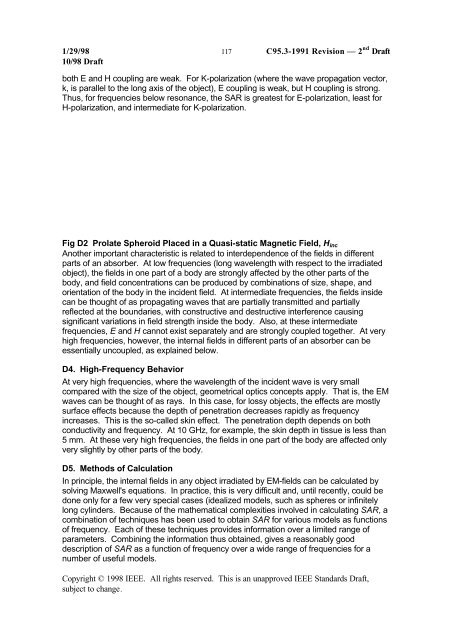DRAFT Recommended Practice for Measurements and ...
DRAFT Recommended Practice for Measurements and ...
DRAFT Recommended Practice for Measurements and ...
Create successful ePaper yourself
Turn your PDF publications into a flip-book with our unique Google optimized e-Paper software.
1/29/98 117 C95.3-1991 Revision — 2 nd Draft<br />
10/98 Draft<br />
both E <strong>and</strong> H coupling are weak. For K-polarization (where the wave propagation vector,<br />
k, is parallel to the long axis of the object), E coupling is weak, but H coupling is strong.<br />
Thus, <strong>for</strong> frequencies below resonance, the SAR is greatest <strong>for</strong> E-polarization, least <strong>for</strong><br />
H-polarization, <strong>and</strong> intermediate <strong>for</strong> K-polarization.<br />
Fig D2 Prolate Spheroid Placed in a Quasi-static Magnetic Field, H inc<br />
Another important characteristic is related to interdependence of the fields in different<br />
parts of an absorber. At low frequencies (long wavelength with respect to the irradiated<br />
object), the fields in one part of a body are strongly affected by the other parts of the<br />
body, <strong>and</strong> field concentrations can be produced by combinations of size, shape, <strong>and</strong><br />
orientation of the body in the incident field. At intermediate frequencies, the fields inside<br />
can be thought of as propagating waves that are partially transmitted <strong>and</strong> partially<br />
reflected at the boundaries, with constructive <strong>and</strong> destructive interference causing<br />
significant variations in field strength inside the body. Also, at these intermediate<br />
frequencies, E <strong>and</strong> H cannot exist separately <strong>and</strong> are strongly coupled together. At very<br />
high frequencies, however, the internal fields in different parts of an absorber can be<br />
essentially uncoupled, as explained below.<br />
D4. High-Frequency Behavior<br />
At very high frequencies, where the wavelength of the incident wave is very small<br />
compared with the size of the object, geometrical optics concepts apply. That is, the EM<br />
waves can be thought of as rays. In this case, <strong>for</strong> lossy objects, the effects are mostly<br />
surface effects because the depth of penetration decreases rapidly as frequency<br />
increases. This is the so-called skin effect. The penetration depth depends on both<br />
conductivity <strong>and</strong> frequency. At 10 GHz, <strong>for</strong> example, the skin depth in tissue is less than<br />
5 mm. At these very high frequencies, the fields in one part of the body are affected only<br />
very slightly by other parts of the body.<br />
D5. Methods of Calculation<br />
In principle, the internal fields in any object irradiated by EM-fields can be calculated by<br />
solving Maxwell's equations. In practice, this is very difficult <strong>and</strong>, until recently, could be<br />
done only <strong>for</strong> a few very special cases (idealized models, such as spheres or infinitely<br />
long cylinders. Because of the mathematical complexities involved in calculating SAR, a<br />
combination of techniques has been used to obtain SAR <strong>for</strong> various models as functions<br />
of frequency. Each of these techniques provides in<strong>for</strong>mation over a limited range of<br />
parameters. Combining the in<strong>for</strong>mation thus obtained, gives a reasonably good<br />
description of SAR as a function of frequency over a wide range of frequencies <strong>for</strong> a<br />
number of useful models.<br />
Copyright © 1998 IEEE. All rights reserved. This is an unapproved IEEE St<strong>and</strong>ards Draft,<br />
subject to change.
















